
ISSN: 2321-9653; IC Value: 45.98; SJ Impact Factor: 7.538 Volume 10 Issue XII Dec 2022- Available at www.ijraset.com



ISSN: 2321-9653; IC Value: 45.98; SJ Impact Factor: 7.538 Volume 10 Issue XII Dec 2022- Available at www.ijraset.com

Abstract: Most of the Agriculture lands in India are over-fertilized with some nutrients and some nutrients are Deficient in the same land. Maximum lands are Overhydrated which results in water wastage. Current automatic watering system uses only a soil moisture sensor and water the plant accordingly to the humidity alone. Development of an IOT based watering and fertilizer dispensing system which is fully automated accordingly to the soil and plant needs. The soil data and plant nutrients required data is initially collected and code is created accordingly and dumped in Arduino and the code can be changed once in a year or once in a plantation season so that the proper cycle can be ensured. This proposed system results in the proper usage of fertilizers and water in an efficient manner. This also paves the way for full-fledged Automation in the Agriculture field.
Keywords: Internet of Things (IOT), Fertilization, Humidity, Temperature, Water level sensor
Agriculture is the backbone of the Indian economy. A country with consistent agricultural magnification can achieve global economic sustainability. A country like India has ideal climatic conditions for growing a variety of agricultural crops. However, land and water are the more critical resources. India is a country. Among these two, a lack of water resources has a significant impact on agricultural crop yield. As a result, water scarcity has an enormous impact on victuals generation. Due to a lack of water, farmers struggle to produce crops, which makes it difficult to feed the world's growing population.
According to the International Water Management Institute (IWMI), 70% of cumulative land-based water consumption is used for domestic, industrial and environmental uses, exacerbating the problem of water scarcity. If such amount of water is used for other purposes, the main use for agriculture will be avoided and people will think about how to best manage water. One such water management method is the irrigation system Irrigation is the method of bringing water to food or cash crops in order to maximize crop yields. The use of irrigation systems is not working optimally, but it is an efficient way to reduce water consumption. This can result in using more water than necessary or not getting enough water to maintain a healthy plant. As stated by the World Bank, irrigation management systems help promote and maintain previously placed water table irrigation systems, improving irrigated areas and increasing yields. Efficient use of water by irrigation systems has been proven to improve agricultural growth. However, the timing of watering depends on factors such as the time of watering and the amount of watering. In modern times, the traditional method of watering crops has been replaced by automated equipment. Benefits of automatic watering systems include reduced utility bills, prevention of uneven watering, and ensuring plants receive the amount of water they need by eliminating water waste. This is not the correct way of farming given the lack of water, wasting water by giving agricultural land that already has sufficient moisture. Therefore, before automatic irrigation, it is necessary to determine that the farmland on this site needs water and how much water the field needs to be irrigated. Soil and plant water conditions, plant growth and phonological stages, water availability, water quality, weather conditions, and the operational importance of irrigation systems are required to create an automated system Various studies have been conducted and most automated systems have been implemented commercially But instead of automation, we integrated an intelligent irrigation system. It has a wide scope for automating the entire irrigation system in time Building an IoT, Irrigation using Arduino IDE with fertilizer and moisture sensor. Also, the Thing Talk server is used to detect the status of the country to receive Soil moisture content. The sprinkler system is also the basis for irrigation system in which water flows through pipes and according to their needs Water required according to national environmental conditions Intelligent identification of humidity, temperature, humidity, etc. The system and power will turn on, providing enough water for the plants The automated system that has been implemented has the following limitations Send warning messages or text messages to mobile phones without saving data Permanently available for future use The purpose of this article is to provide intelligent information Irrigation system with automatic device and data storage in IoT Cloud, and type styles are built-in; examples of the type styles are provided throughout this document and are identified in italic type, within parentheses, following the example. Some components, such as multi-levelled equations, graphics, and tables are not prescribed, although the various table text styles are provided. The formatter will need to create these components, incorporating the applicable criteria that follow.
ISSN: 2321-9653; IC Value: 45.98; SJ Impact Factor: 7.538 Volume 10 Issue XII Dec 2022- Available at www.ijraset.com

Jinling et al proposed a quantitative remote control system for greenhouses based on the Global System for Mobile GSM-SMS, which sends temperature, ambient temperature and humidity status by SMS, and controls watering equipment via remote machines. Factories use sensors and automation devices [1] Gautam and Reddy proposed an innovative remote-controlled on-board irrigation system based on GSM Bluetooth [2] Suresh et al proposed an architecture based on the capabilities of current and next generation microcontrollers and their application requirements [3]. The microcontroller used in this system promises to extend the life of the system by reducing power usage through reduced power consumption Kansara et al proposed a smart irrigation system using IoT [4] They offer irrigation techniques that minimize human intervention. If the bypass temperature and humidity change, the sensor reads the temperature and humidity change and sends a signal to interrupt the microcontroller to enable or disable the setting. Archana and Priya proposed a microcontroller-based system to monitor water level and irrigated area [5] Sensors are present to check the presence of water in the fields.
Once the field is dry, the sensor detects the need until the sensor is deactivated again Anitha proposed a waste monitoring system using IoT, which uses sensors on the lid of the bin to detect the level of waste based on the height of the bin [6] Uddin et al proposed a variable irrigation system model based on an automatic microcontroller [7] Solar energy is only used as a power source to control the whole system Sensors are placed on the rice fields, these sensors constantly detect the water level and transmit the information to the farmers who inform the water level.
Farmers can get information on water levels without having to visit the rice fields. Depending on the water level, the farmer can even control the car remotely by sending messages from his phone. However, if the water level reaches a dangerous level, the engine will start automatically, no statement from the farmer is required to determine the correct water level on site Chavan and Karande propose to develop transparent wireless sensor networks (WSN) for agricultural environments. Monitoring of various agricultural environment factors such as soil moisture, Temperature and humidity, among other factors, can be critical [8]. Traditional methods of quantifying these factors in agricultural settings involve individuals performing the quantification manually and examining them at different times This article studies a remote monitoring system using Zigbee These nodes send the data wirelessly to a central server, which collects the data, stores and approves it for analysis, then displays it on demand and can also be sent to the customer's mobile phone. Anitha proposed a home security system using IoT [9] The system will notify the owner of any unauthorized access or door opening by sending a notification to the user Once the user has received the notification, they can take the necessary action. The security system will use a microcontroller called Arduino Uno to connect the components, a reed sensor to monitor status, a buzzer to trigger the alarm, and an ESP8266 Wi-Fi module to connect to the internet and communicate. The main advantages of such a system include ease of installation, low cost and low maintenance Parameswaran et al discussed irrigation systems based on soil moisture [10]. The moisture sensor is used to detect soil moisture and it is based on a solenoid valve In addition to climatic conditions, crops need to be watered knowing the pH of water and soil to produce better crops Monitors are used to display pH, moisture content and temperature This will improve the agricultural system to increase productivity
The template is used to format your paper and style the text. All margins, column widths, line spaces, and text fonts are prescribed; please do not alter them. You may note peculiarities. For example, the head margin in this template measures proportionately more than is customary. This measurement and others are deliberate, using specifications that anticipate your paper as one part of the entire proceedings, and not as an independent document. Please do not revise any of the current designations.
The fertigation system is configured with various essential components aslisted as follows. 1) Arduino Uno 2) Fertilizer sensor 3) Moisture sensor
The software requirements are Arduino application, MIT App Inventor
ISSN: 2321-9653; IC Value: 45.98; SJ Impact Factor: 7.538 Volume 10 Issue XII Dec 2022- Available at www.ijraset.com

Arduino Uno is a PC equipment, that is open source which organizes the components by the programming language and integrates the enterprise with the client groupto produce microcontroller packs. These micro-controlledpacks are used as an intelligent agent which was programmed to detect and to control working of the system in the real-life Sample Arduino Uno is shown in Fig. 1. Generally, Arduino boards are inexpensive and used in various operating systems. It is easy and flexible for the beginners. It is compatible with various languages such as C++ and JAVA
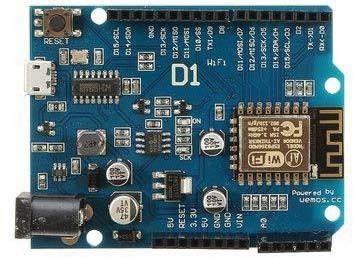
Fig 2 shows the fertilizer sensor. The sensor, measures levels of ammonium in soil – the compound that is converted to nitrites and nitrates by soil bacteria. Using a type of AI called machine learning, it combines this with weather data, time since fertilization, pH, and soil conductivity measurements. It uses this data to predict how much total nitrogen the soil has now and how much it will have up to 12 days in the future, to predict the optimum time for fertilization.
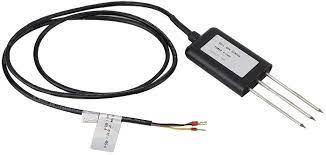
The Fig.3 shows a sort of soil moisture sensor. It contains two tests by methods for which current will go into the dirt, at that point scrutinizes the obstruction of the soil, which will peruse the dampness level. We know the nearness of the water makes the dirt more inclined to lead the power effortlessly, which implies R(resistance) is less in the such kind of soil, while dry soil has poor conductivity of intensity, in this way dry soil upholds more insurance than the wet soil. Sensor is structured on this property of intensity. There should be a point that believers the obstruction into voltage, this is done using circuit which show inside the sensor, which changes over the opposition into voltage.
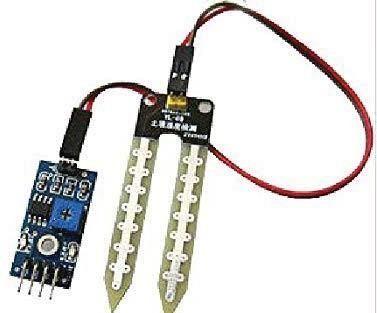
ISSN: 2321-9653; IC Value: 45.98; SJ Impact Factor: 7.538 Volume 10 Issue XII Dec 2022- Available at www.ijraset.com




Fig 4 shows the water pump. A water pump is a machine used to increase the pressure of water in order to move it from one point to another. Modern water pumps are used throughout the world to supply water for municipal, industrial, agricultural, residential uses. Water pumps are used to provide high irrigation efficiency by supplying proper amount of water to every area of the field to gain speed in cultivation. Low maintenance is required as it they come with less moving parts which easesthe work.
A relay is an electrically operated switch. It consists of a set of input terminals for a single or multiple control signals, and a set of operating contact terminals. Relays are electric switches that use electromagnetism to convert small electrical stimuli into larger currents. These conversions occur when electrical inputs activate electromagnets to either form or break existing circuits. Change contacts easily. Isolates the activating part of the actuating part. It works well at high temperatures. It is activated with low current, however, it can activate large machines of great power.
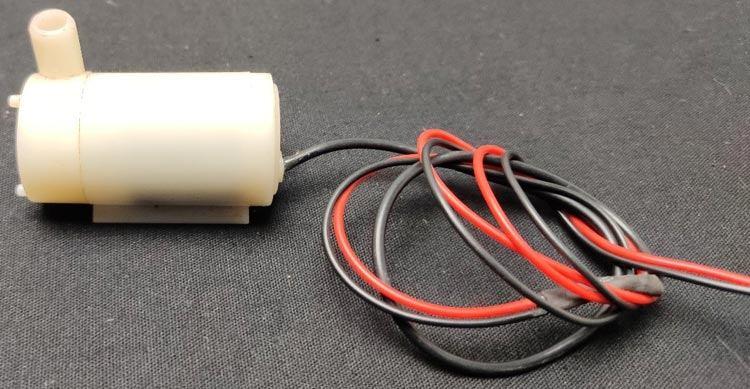

The primaryaim of the project is to develop a framework to stay track of remote soil wetness from an abroad area and to deal with the moisture of soil so it doesn't influences the products. The IOT basically based arranged framework given amid this examination are valuable to achieve such an undertaking. The prototype framework examination of this study enables monitoring any agricultural arrive and keeps up moisture of the dirt. This thought will unquestionably encourage any country move to sensible Agriculture. The framework is foreseen to figure and create records in period.The real execution of the framework would require changes in detecting component, innovations and supply code in spite of the fact that the approach and control remain steady. The proposed system was demonstrated with the help of Thingspeak cloud. ThingSpeak is an IOT analytics place to accommodate to sanctions to aggregate, depict and analysereal-time data streams in the cloud. ThingSpeak gives instantenvision of data posted by the contrivances with the competency to execute MATLAB code. Additionally , it is often utilized for prototyping and proof of concept IOT systems that require analytics.

ISSN: 2321-9653; IC Value: 45.98; SJ Impact Factor: 7.538 Volume 10 Issue XII Dec 2022- Available at www.ijraset.com

The data is first collected from the different sensors here Sensors like Moisture level of soil, Temperature of the area, air moisture and Water Level are used. They are attached toa breadboard which is intern connected to the Arduino Board. The data from the board is sent to the Arduino IDE. The programming language that is used runs instructions which extracts the data and reflects. If the data is not valid then theprocess ends is clearlyshown in Fig. 6 and Fig. 7
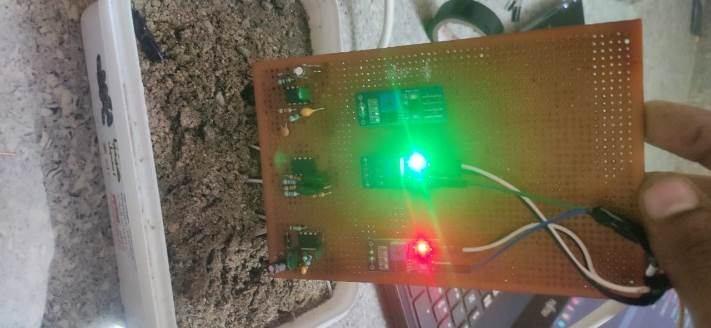
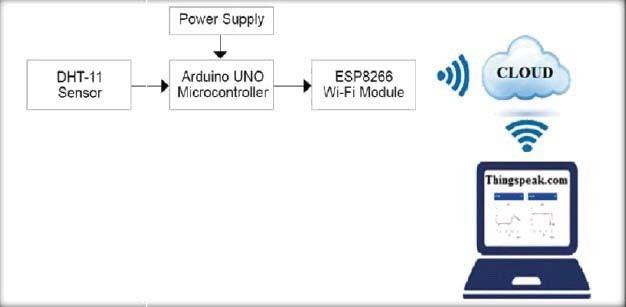
Fig.7Data flowdiagramoftheproposed system
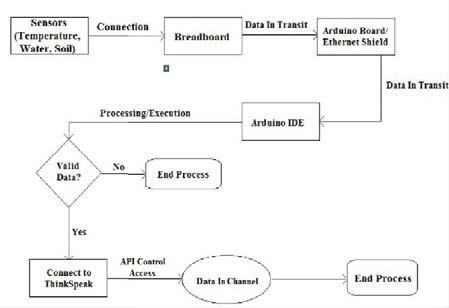
In the proposed system, our idea is to develop a framework which can help in a programmed water system gadget through concentrate the dampness level of the field. The shrewd water system contraption ends up being a valuable gadget since it robotizes and manages the watering with no guide intercession. The essential bundles for this mission are for agriculturists and plant specialists who do now not have enough time to water plants. The dampness sensors and temperature sensor degree the dampness degree (water substance) and temperature of the unmistakable vegetation. On the off chance that the dampnesslevel is situated to be underneath thecoveted level,the dampness sensor sends the flag to the Arduino board which triggers the Water Pump to appear ON and supply the water to particular plant. The machine might be likewise drawn out for out of entryways utilization. The working model of the proposed system was depicted in Fig.8 and Fig.9.
ISSN: 2321-9653; IC Value: 45.98; SJ Impact Factor: 7.538 Volume 10 Issue XII Dec 2022- Available at www.ijraset.com

Fig9. Completeconnection oftheproposedmodel
The experiment was carried out by taking the input from the DHT11 sensor. The moisture sensor gives analog output which can be read through the ESP8266 NodeMCU analog pin A0. Since the NodeMCU cannot give output voltage greater than 3.3V from its GPIO so we are using a relay module to drive the 5V motor pump. Also the Moisture sensor and DHT11 sensor is powered from external 5V power supply. The data collected from various sensors are listed in the table below. Table.1 contains the data from Temperature, sensor, humidity sensor, Soilmoisturesensor and water levelsensor indicatedas attributesasA1,A2,A3,A4respectively.
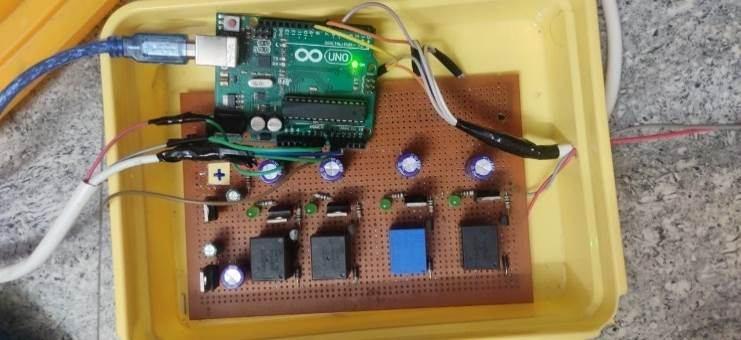
Created atDate CreatedTime entryid
A1 A2 A3 A4
09 March 2022 07:22:2 4 113 35 51 49 107 6 23 March 2022 07:28:3 1 191 40 72 48 547
17 March 2022 06:18:2 4 138 37 71 44 589 22 March 2022 07:19:5 2 118 29 68 40 132 4 13 March 2022 07:27:1 6 132 32 51 49 562 23 March 2022 08:05:1 0 174 37 61 33 112 9 09 March 2022 07:21:2 8 165 36 61 45 703
19 March 2022 06:01:5 4 172 33 77 45 674
21 March 2022 08:36:2 6 180 38 53 34 137 9 20 March 2022 07:37:2 6 180 26 78 32 123 0
08 March 2022 08:49:1 1 176 28 50 28 138 5
14 March 2022 07:48:1 1 113 36 70 25 421 20 March 2022 08:08:3 6 105 38 57 35 140 1
ISSN: 2321-9653; IC Value: 45.98; SJ Impact Factor: 7.538 Volume 10 Issue XII Dec 2022- Available at www.ijraset.com

10 March 2022 06:59:3 7 108 29 71 46 136 9
11 March 2022 06:30:2 2 159 40 78 27 304
14 March 2022 07:46:5 5 105 32 71 37 124 2
23 March 2022 07:03:5 2 130 36 61 33 948
16 March 2022 07:50:1 5 148 39 79 39 356
08 March 2022 06:10:0 9 128 30 80 31 625 05 March 2022 06:09:1 0 107 26 67 35 729 20 March 2022 08:58:2 6 175 36 71 31 659 23 March 2022 06:33:0 5 159 38 64 43 986 26 March 2022 07:02:1 4 108 34 55 25 368
19 March 2022 06:21:1 9 146 34 57 43 138 8 28 March 2022 08:11:0 7 161 25 65 41 589
19 March 2022 08:14:1 8 146 34 66 39 804 29 March 2022 07:02:3 4 186 33 56 34 827
11 March 2022 08:40:5 2 158 28 65 50 545
07 March 2022 07:10:1 8 163 32 72 34 785
04 March 2022 07:26:4 7 129 33 58 33 126 2
19 March 2022 08:12:4 2 136 32 67 27 680
27 March 2022 06:31:0 6 103 37 69 45 111 1
16 March 2022 07:25:2 3 199 31 73 47 146 9
08 March 2022 06:42:4 3 190 37 76 29 428
10 March 2022 06:49:0 4 189 40 65 30 916
ISSN: 2321-9653; IC Value: 45.98; SJ Impact Factor: 7.538 Volume 10 Issue XII Dec 2022- Available at www.ijraset.com

The temperature recorded by the DTH11sensor from the various dates and from various time period on various places of Vellore shown below in Fig. 10
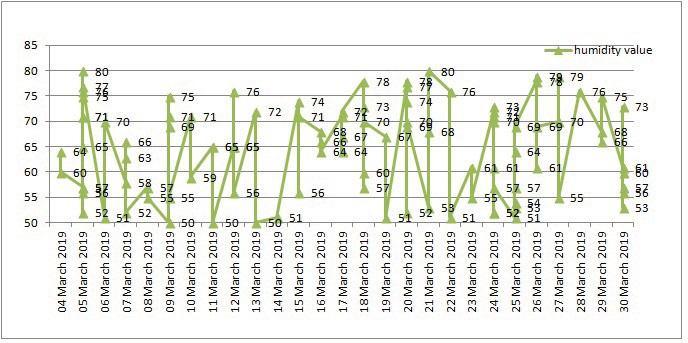
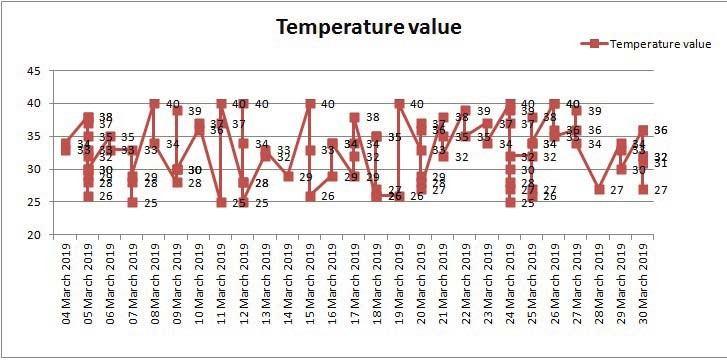
Similarly, the humidity recorded by the DTH11 Sensor from various places are depicted in the graph below as Fig. 11
The soil moisture level recorded by the soil moistersensors are depicted graphicallyin Fig.12.

Fig.12 Soil moisture recorded by soil moisture sensor
The water level sensor is used to record the water level from the various places of the fields of the Vellore districts. This is clearly shown in the following Fig. 13.
ISSN: 2321-9653; IC Value: 45.98; SJ Impact Factor: 7.538 Volume 10 Issue XII Dec 2022- Available at www.ijraset.com

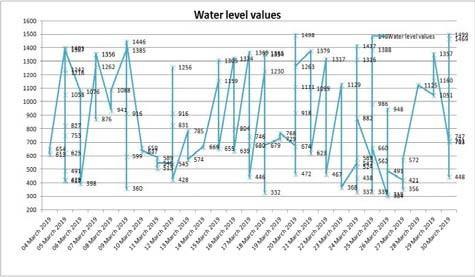
These data are imported in the Thingspeak cloud for the visualization and the correlation between the temperature and humidity is calculated. The correlation between the temperature and humidity places important role in watering the plants. So based on the correlation we can start the irrigation system or switch off. The correlation is shown in the following Fig. 14 using the Mat lab visualization app using Thingspeak.
Fig14. Correlationmapbetween temperature
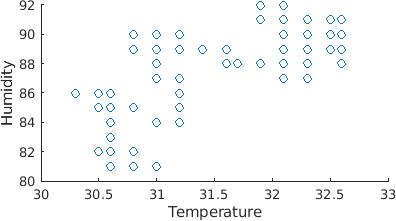
humidity Theworking spaceofArduinowasdepictedin theFig.15
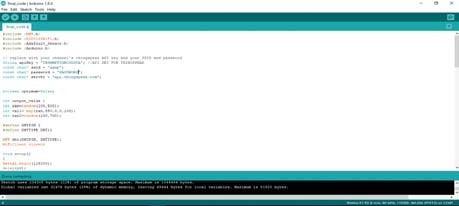
The novelty of the proposed work is that so far much of the research related with irrigation system usually record the data and send SMS or alarm to the owners to indicate the need of watering or to switch off the water supply. But the proposed work automatically switch on and off using the data recorded by various sensor. Also the recorded data is stored in the cloud for futurepurpose.
The data collection from soil and plant nutrition requirements is like a servicing process that must be repeated once in a season or once a year so, in future this procedure will also be automated in a cost effective manner. The sand and the water level are the critical parameter for the development of smart irrigation system. Generally, the soil moisture is affected by a sundry parameters such as air temperature, soil temperature, air humidity, ultra violet rays, and much more. This paper proposed an IoT based smart irrigation system utilizing sensors to record the data and store it in the cloud storage. The future work can be prediction of soil moisture using the recorded data and it may provide cost effective. The auto mode makes it a smart system and it can be further customized for application categorical scenarios. The future plan is to conduct a water saving analysis based on proposed algorithm with multiple nodes along with minimizing the system cost.
ISSN: 2321-9653; IC Value: 45.98; SJ Impact Factor: 7.538 Volume 10 Issue XII Dec 2022- Available at www.ijraset.com
[1] G S. Jin, S. Jingling, H. Qiuyan, W. Shengde, and Y.Yan, “A remote measurement and control system for greenhouse based on gsm-sms,”. In 2007 8th International Conference on Electronic Measurement and Instruments IEEE. pp. 2-82, August 2007.
[2] I. Gautam, and S.R.N Reddy, “Innovative GSM bluetooth based remote controlled embedded system for irrigation”. International Journal of Computer Applications, vol 47, pp.1-7,2012.
[3] R. Suresh, S.Gopinath, K. Govindaraju, T. Devika and N.S. Vanitha, “GSM based automated irrigation control using raingun irrigationsystem”, International Journal of Advanced Research in Computer and Communication Engineering”, vol 3, pp.5654-5657, 2014.

[4] K. Kansara, V. Zaveri, S. Shah, S. Delwadkar, and K.Jani, “Sensor based automated irrigation system with IOT: a technical review”, International Journal of Computer Science and Information Technologies, vol 6, pp.5331-5333, 2015.
[5] P. Archana, R. Priya, “Design and implementation of automatic plant watering system”, International Journal of Advanced Engineering and Global Technology, vol 4, pp. 1567-1570, 2016.
[6] A. Anitha, “Garbage Monitoring System Using IoT”. IOP ConferenceSeries. Materials Science and Engineering, pp.420-427, 2017
[7] M. Uddin, “Measurements of evaporation during sprinkler irrigation”, (Doctoral dissertation, University of SouthernQueensland). 2012
[8] C.H. Chavan, and P.V. Karande, “Wireless monitoring of soil moisture, temperature & humidity using zigbee in agriculture”. Int. J. Eng. Trends Technol, vol 11, pp. 493-497, 2014.
[9] A. Anitha,“Home security system using internet of things”. In Materials Science and Engineering Conference Series, vol. 263, pp.1-11, 2017.
[10] G. Parameswaran, and K. Sivaprasath, “Arduino based smart drip irrigation system using Internet of Things”. Int. J. Eng. Sci, 5518, 2016.
